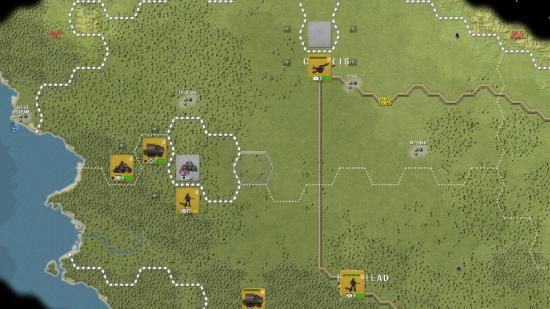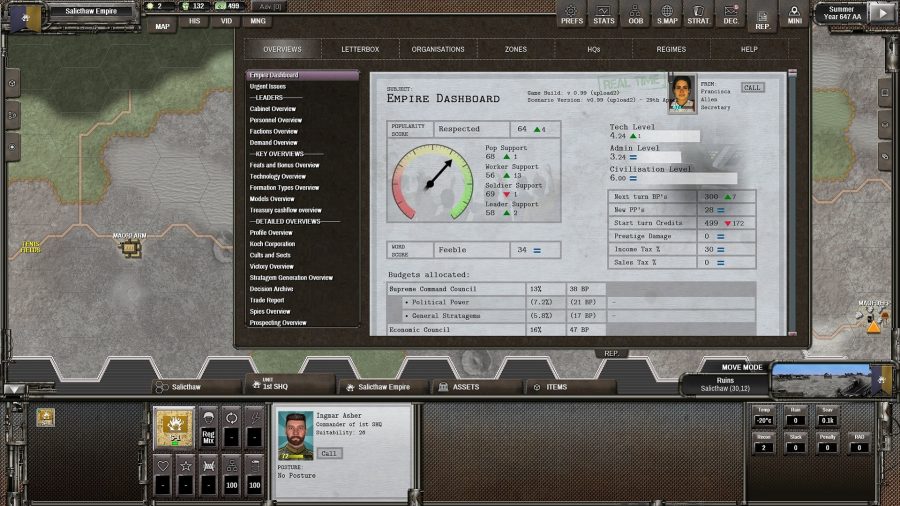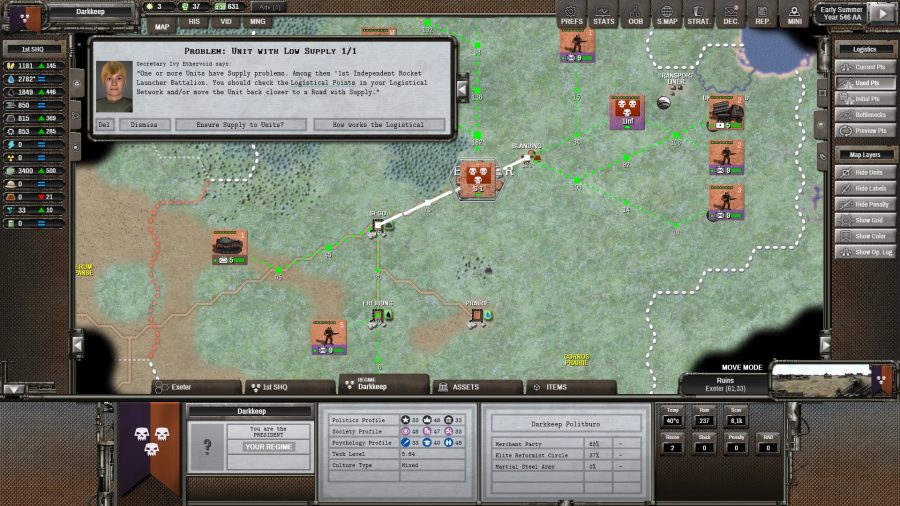Some games try to capture a certain feeling through their gameplay and presentation. Some try to recreate the harsh reality of battlefield command through spartan visuals and dense menus, evoking a sense of determined seriousness. Others try to feel like a grand drama, pulling on Hollywood or epic novels to create an atmosphere that entangles you in the experience.
Shadow Empire, the latest 4x wargame from Slitherine/Matrix, tries to evoke both the hard sci-fi of the novels of the 1980s-90s and the feeling of playing a wargame circa 1996. Imagine if you will:
The vague words ‘Shadow Empire’ stare up at you in scrawled sharpie from the front of a bootleg CD. You wonder what kind of game it is. You pop it into your parent’s Windows 98’s disk drive. Stars and the dunes of a desert planet are the only visual accompanying the install. It takes 2 hours. Finally, you launch the game. Infinite worlds. Detailed interpersonal and interstate relations played out through dialogue boxes and relation scores. Logistics and grand strategy. The tactical application of artillery. Cults, Corporations, 6 foot carnivorous Crab Analogs.
It has everything you’ve ever seen and read in sci-fi. Your dewy child eyes shine wider and wider. You have just found the thing you will obsess over for the next year. Twenty years from now, a company will try to reboot it and they will get close, but it won’t be the same.

You’ll still fondly think of the time you spent trying to figure out where bureaucratic points came from and why the Freemen never performed as well in combat as they seemed to in Dune. Shadow Empire could have been made in 1996, but instead we get it now, in 2020, when games of its calibre and this vision are few and far between.
Shadow Empire is the Alpha Centauri of today, only better. Yeah, I said it.
Shadow Empire is a multi-genre game. The base experience is a 4x strategy game. You explore, expand, exploit, and exterminate your surroundings and then your rival empires. It goes above and beyond by fusing the classic 4x gameplay with an interpersonal relationship system reminiscent of Paradox’s Crusader Kings II, some classic RPG elements in character progression and stat increases, an extremely detailed ‘hex and chit’ wargame, and then wraps it all up in a classic sci-fi narrative and visual package.
Each game begins with world generation. This is a detailed process that not only defines the battlefield you’ll be fighting over and colonizing, but also helps create the narrative background of that world. I had one game on a lush jungle world. The population was huge, even after the simulated apocalypse that begins every game. Battles were fought in dense jungle and across wide, wealthy farming districts. Another world, a moon world, had zero liquid water, no food, and no atmosphere. The population was under 1,000,000.
Every life mattered, to a degree, and the logistical nightmare of trying to sustain an army laying a 6-year siege to an enemy city-dome led to fascinating gameplay. Finally, I tried a game on an earth analogue. Radiation plagued half the planet, forcing extreme investment in anti-radiation hospitals and hazard suits for every soldier. Things were expensive, but manageable. Everything changed when the mutants attacked. The variety of experiences that Shadow Empire brings to each new game feels almost endless; a great thing for replayability.
Game turns have you dealing with your cabinet, the denizens of your zones, your militia, in addition to the corporations and cults that emerge and compete for the attention of your staff and citizens, on top of all the usual 4X gameplay loops. These systems really make you feel like you’re one person trying to run a nation that requires hundreds to operate. Yes you can send in security personnel to deal with the workers strike, but the workers will remember this and the head of your scientific research bureau will never forgive you for it. To top it off, the freemen who dot the countryside might think twice about migrating to your city.
If only you could make them realize how important it was to finish producing that metal; the frontline is only a dozen hexes to the west and needs replacement parts! The militia realizes, however, and so does the corporation.
Managing everyone and everything is 90% of gameplay, but the depth combined with the interpersonal RPG elements keep it fresh. I was genuinely shocked when my advisor turned traitor and led a rebellion in the northern wastes. I was also not at all surprised to find an incompetent governor was the one stealing funds. He was quickly ‘promoted’ to a frontline position.
A system of fate points and stratagems keep turns from being endless menus. These cards are generated by each of your bureaus. The Foreign Office might generate a card for trade rights with a major faction while Internal Affairs might give you one to root out a corrupt official.
Down to Earth: These are the very best WW2 games
Both of these are generated based on the funding and bureaucratic points given to each bureau, which of course affects the relationships you have with the leaders of those bureaus. Managing your politics and the stratagems you use is a big part of diplomacy and development in Shadow Empire. On top of that, some events generate fate cards.
These are always good, sometimes miraculously good, but they come at a cost. Fate points generate very slowly, but you can get more by playing a negative fate card. These range from a morale dip in your volunteers, to catastrophic cracks in atmosphere domes and plagues that ravage your zones. Weighing the pros/cons is all the more interesting when you’re deciding on something awful happening.
There is so much to balance that you’ll stumble here and there, and that’s fine. Dealing with the ups and downs of governance is what Shadow Empire does best, but it isn’t the only thing done well. The wargame aspect, lifted from the studios previous game – Advanced Tactics – is equally detailed and engaging. Logistics and command are king, as they should be, but RnD, training, and morale are also crucial. Getting my men padded envirosuits was probably the turning point in the skirmishes against the raiders that infested the forests near my capital in one game.
The next, securing and expanding the truck relays, ensuring adequate food and munitions reached my besieging artillery units half a world a way was essential. So far, I’ve fought several different wars across several different planets and I know I haven’t seen everything the game has to offer. Tech research starts at Mad Max and seems to end at Warhammer 40K. I hear whispers of mechs on the wind, though I still haven’t been able to build any.
A moment to talk aesthetics. Most of the time you’ll be looking at a Hex map of the planet you’re fighting over. Units with NATO symbols and representative images scatter here and there. Boxes and triangles and little icons represent cities, construction, and special hex bonuses. Surrounding the map is a myriad of information and menus. Clicking on any of them will send you deeper and deeper into the fine mechanics driving Shadow Empire.
Want to know why your precious metals refining plant at 22,10 is only producing 94% this turn, I guarantee you can find out why if you go digging deep enough. This means you’ll be spending a good amount of time each turn looking at these screens and their figures.
This is an information dense game, and those who excel in managing complex systems will be like kids in a candy store in Shadow Empire. Beyond the menus and maps, this game opted for a strange visual aesthetic that I have to assume was intentional.
Complex ops: Read our Command: Modern Operations review
Every individual official and officer you deal with has a portrait that looks straight out of The Elder Scrolls 2: Daggerfall. They’re ugly, simple as that. Stratagem Cards and the images that accompany the start of turn news and updates also use the same odd design choice. Some images look like several 90s adventure game backgrounds were spliced together with terrifyingly robotic characters slapped on top of them.
It’s so ugly that I have to conclude that it was an intentional throwback to the 90s and the type of strategy games that would enthrall a young me for weeks and weeks. They do it so well that I won’t complain about the visuals. They add to the charm.
Enthralling me is exactly what Shadow Empire has done, though. Every time I sat down to write this review I thought to myself: “Well, I should probably play a little more, just to make sure everything stays consistent for a little while longer.” I would play for hours. I don’t think there’s much higher praise to be given to a game. I would like more, of course.
I started seeing some repeated events pop up with my staff here and there, for example. I would love to see naval and air combat get some love, and if I’m being really ambitious, I would love to see the game venture back into space once your first planet is conquered.
There was an entire galaxy of humans before the fall, after all. If you’re interested in 4X games, or even more into traditional wargames and want to see something that gives greater weight to the consequences of combat, give Shadow Empire a try. There’s really been nothing like it in quite a long time and I doubt we’ll see its like again.
This review was kindly donated to Wargamer by the author.





